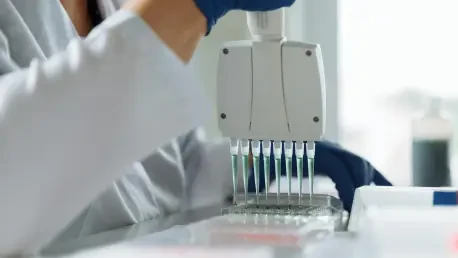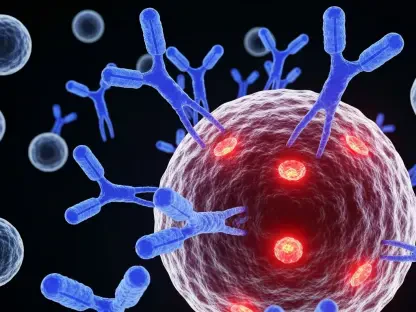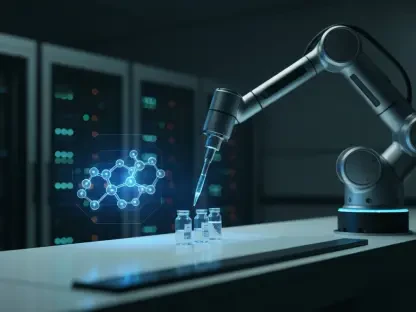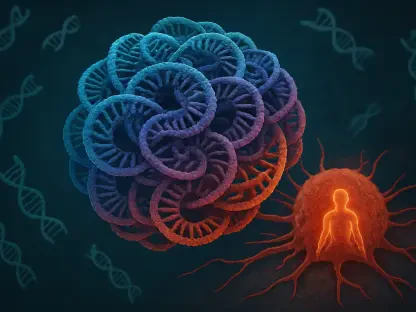The world has long been challenged by the persistence of per- and polyfluoroalkyl substances, commonly known as PFAS, due to their stubborn nature and resistance to environmental degradation. These chemicals are essential in numerous industrial applications, leading to an accumulation in ecosystems and potential health risks to humans. However, a remarkable initiative led by high school students has introduced an innovative approach using cutting-edge artificial intelligence and synthetic biology to tackle the PFAS crisis. By harnessing AI’s potential, these young minds have sought to develop enzymes capable of effectively breaking down these notorious “forever chemicals.”
An Unexpected Beginning in Synthetic Biology
The Birth of an Ambitious Mission
At the California Institute of Technology, a group of ambitious high school students gathered to participate in a prestigious competition known as the International Genetically Engineered Machine (iGEM). This platform is one of the world’s premier synthetic biology competitions that encourages young minds to solve critical global issues through innovative biological designs. Among the participants was a particularly driven team from Southern California, named the PFAS Annihilators, well known for their unique approach leveraging AI to design enzymes targeting the degradation of PFAS. Their journey began on a sunny Saturday morning when these students laid the groundwork for a project that would soon capture international attention. Engaging in collaborative discussions and spirited brainstorming sessions, they formulated a bold plan to use artificial intelligence as a tool in designing specific enzymes to dismantle the strong carbon-fluorine bonds inherent in PFAS.
The importance of addressing PFAS contamination cannot be overstated, as these chemicals have proven resistant to breakdown due to their carbon-fluorine bonds—the strongest single bonds in organic chemistry. Consequently, traditional methods of treating PFAS have often been fraught with difficulties and inconsistencies. Recognizing the unique capabilities of AI, the PFAS Annihilators embarked on an experimental path, investing considerable effort in training a large language model (LLM) to assist in the creation of specialized enzymes. The road ahead was uncharted, filled with both obstacles and opportunities, as students sought to advance their understanding and practical application of synthetic biology.
Developing the AI Model
The PFAS Annihilators faced numerous challenges, primarily centered around the need to develop an AI model capable of engineering enzyme candidates that could efficiently break down PFAS. Leveraging a large language model, the students aspired to create modifications of naturally occurring enzymes, enhancing their ability to degrade the resilient carbon-fluorine bonds in PFAS compounds. Their journey took an exciting turn upon the discovery of a natural enzyme named A6RdhA, which is produced by a soil bacterium and contains potential attributes useful in their quest. The process of tailoring this enzyme to effectively target PFAS, however, was anything but straightforward.
The students had to contend with the complexities of protein design, a task made more daunting by the incomplete protein sequence of their chosen enzyme. Undeterred, they turned to an extensive repository of protein sequence databases, generating thousands of potential sequences through computational modeling. From this enormous pool, they aimed to identify novel chimeric enzymes by creating hybrids of A6RdhA and structurally similar proteins. This phase of the project highlighted the intersection of computational biology, engineering, and creativity, as students ventured into uncharted territory to develop new molecular architectures capable of unbinding the “forever” nature of PFAS.
Navigating the Complexities of Lab Work
Challenges in Protein Expression
The endeavor to synthesize the newly designed enzymes in laboratory settings presented a series of formidable challenges for the team. Producing AI-designed proteins is often fraught with technical issues, as cellular systems may not readily recognize or properly fold foreign sequences. These limitations have historically stymied similar projects within the field of synthetic biology. In addressing this challenge, the PFAS Annihilators opted to utilize a specialized cell-free system, supplemented with specific cofactors necessary for successful enzyme expression. This approach allowed the team to circumvent some of the traditional pitfalls associated with cellular expression systems, all while maintaining focus on achieving operational enzymes in practical testing environments.
Their persistence eventually bore fruit, as they succeeded in synthesizing several iterations of their engineered enzymes. This achievement was particularly noteworthy given the myriad of obstacles faced in producing viable protein candidates designed and initially constructed via AI systems. Through meticulous attention to detail and an unwavering commitment to problem-solving, the PFAS Annihilators transformed theoretical concepts into tangible laboratory successes.
Intricacies of Enzyme Functionality
Enzyme functionality hinges on a delicate interplay of structural integrity and chemical activity, with even the smallest variations in sequence potentially yielding substantial changes in performance. As such, the process of fine-tuning their AI-designed enzymes involved comprehensive testing to assess stability, operational viability, and efficacy in PFAS degradation. This phase required extensive iterations and methodical experimentation to evaluate the enzymatic capabilities to address the PFAS challenge meaningfully.
The students embraced a systematic approach, employing iterative sampling and rigorous statistical models to derive insightful data from their lab experiments. The culmination of this phase was rooted in their ability to demonstrate real-world applicability, thereby reinforcing the foundational principles of sustainable chemical processes through enzymatic action. By advancing the state of biological degradation mechanisms, the PFAS Annihilators underscored the potential for future applications of AI-assisted enzyme design within complex environmental contexts.
A Journey of Recognition and Collaboration
International Recognition and Rewards
Participation in the iGEM competition not only provided a platform for the PFAS Annihilators to showcase their innovation but also brought them face-to-face with a global audience, enhancing the visibility of their groundbreaking project. The opportunity to present their findings at the iGEM Grand Jamboree held in Paris marked a pinnacle moment, offering a stage for the students to share insights, foster cross-cultural collaboration, and gain valuable feedback from peers and experts alike.
Thanks to several generous contributions, the team’s Paris-bound expedition became a reality, leading to astonishing accomplishments including a coveted Silver Medal and a distinguished award for their computational methodologies. Overcoming the initial anxieties associated with international travel and competition, they embraced the invaluable experiences garnered through networking and dialogue with diverse scientific communities. It was a testament to the power of global scientific collaboration and the role such initiatives can play in propelling research beyond traditional borders.
Continued Work and Future Directions
Following the excitement of their success in Paris, the PFAS Annihilators have remained steadfast in improving their research approach, focusing on overcoming logistical hurdles such as enzyme shipping conditions to facilitate smooth experimental testing. Collaborations with respected institutions, including MIT’s Furst Lab, have been integral in shaping the students’ progressive experimental phases. These partnerships laid the foundation for further validations, indispensable for ensuring enzyme efficacy in sustained PFAS breakdown.
There is recognition among the scientific community of the technical complexities associated with eliminating PFAS at scale. Nonetheless, the conceptual frameworks established through the PFAS Annihilators’ initiative offer promising pathways for future exploration into AI-assisted protein engineering. The project also underscores the transformative potential of cross-disciplinary scientific inquiry—a beacon for successive generations aiming to unravel similarly persistent challenges.
The Environmental and Technological Impact
Potential Shifts in Environmental Strategy
As environmental agencies and researchers globally race against time to devise effective solutions for PFAS containment, the breakthrough achieved by these young innovators propels the discourse toward a paradigm shift in remediation strategy. Traditional chemical treatment methods have been scrutinized for their environmental impact and resource intensiveness, often resulting in secondary pollution or partial treatment. The intrinsic advantage of leveraging biodegradation lies in its alignment with nature-inspired processes, which can potentially offer integrated pollution management solutions.
AI-driven enzyme design, as exemplified by the PFAS Annihilators, signifies a progressive shift toward more sustainable chemical treatments, emphasizing the synergy between technology and ecology. Streamlining treatment pathways through tailored enzymatic action can impact industries ranging from wastewater management to industrial manufacturing, bearing the potential to revolutionize approaches to persistent chemical contaminants. As societies become increasingly conscientious about environmental operations, such initiatives are paving the way for eco-friendly approaches within the broader domain of atmospheric and aquatic remediation.
Broader Implications for Science Education and Research
The ramifications of the PFAS Annihilators’ project stretch beyond ecological remediation, emphasizing the profound influence of science education and interdisciplinary research. By engaging young students in real-world problem-solving scenarios, educational frameworks can foster enthusiasm, creativity, and rigor in pursuing scientifically significant inquiries. This project’s spirit bridges academia and applied research, empowering students with the confidence and tools to address critical global challenges beyond the confines of traditional classrooms.
Moreover, the project serves as a beacon, illustrating the utility of AI and synthetic biology in tackling complex issues. As science education continues to evolve, illustrating successful applications of state-of-the-art methodologies can serve as inspiration for budding researchers, instilling a commitment to lifelong learning and exploration. The blend of mentorship, cutting-edge technology, and the insightfulness demonstrated by the PFAS Annihilators contribute to a vibrant narrative where the next generation forges the path toward sustainable futures.
Pioneering the Future of Chemical Breakdown
The world has been grappling with the challenge posed by per- and polyfluoroalkyl substances, or PFAS, for decades. These compounds are notoriously tough to break down in the environment, earning them the nickname “forever chemicals.” Widely used across various industries for their unique properties, PFAS have accumulated in ecosystems, raising alarms about their impact on both the environment and human health. The persistence of these chemicals in water, soil, and air means traditional methods of degradation are ineffective, leaving scientists and governments searching for viable solutions.
In an inspiring turn of events, a group of innovative high school students has embarked on a mission to address the PFAS dilemma. By integrating advanced artificial intelligence with the promising science of synthetic biology, they aim to conquer this environmental challenge. The students have focused on designing enzymes with the potential to break down PFAS effectively. Their approach combines AI’s powerful data processing capabilities with the flexibility of synthetic biology to create enzymes tailored for the task. These pioneering efforts by young minds offer a potential breakthrough in dealing with an issue that has long puzzled experts, highlighting the importance of innovation and collaboration in tackling global challenges. Their work demonstrates not only scientific creativity but also the innovative spirit needed for solving complex problems.









